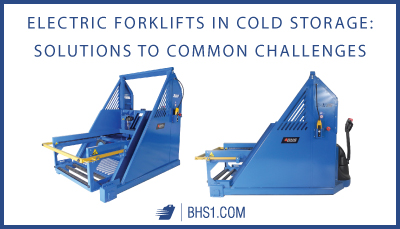We use cookies to make your experience better. To comply with the new e-Privacy directive, we need to ask for your consent to set the cookies. Learn more.
Electric Forklifts in Cold Storage: Solutions to Common Challenges
Cold storage facilities are the backbone of the supply chain for crucial products, including frozen and refrigerated foods, pharmaceuticals, and petrochemicals. Unfortunately, the extreme temperatures needed to preserve perishables can reduce efficiency in electric forklifts — or even damage them outright. Thankfully, there are a number of mitigating strategies that can improve forklift performance in cold storage applications. For instance:
Be aware of condensation and the problems it can cause.
When lift trucks move from cold storage areas to ambient temperatures, condensation can form on batteries and other parts. This poses a number of threats to equipment, including corrosion and premature wear. When forklifts return to cold areas, the condensation can freeze, causing even more problems.
Because of this, experts recommend that operators keep their lift trucks in cold storage areas for an entire shift instead of moving back and forth between temperatures. Once a shift is over, the truck can move to an ambient temperature where it can dry out completely before returning to the cold.
When batteries must be changed mid-shift, a Mobile Battery Extractor can help. These extractors enable changeouts anywhere in facility, including cold storage areas. By performing the changeout in the cold, operators can avoid troublesome condensation that occurs after entering an ambient temperature setting.
Fleet management is paramount.

Cold temperatures sap battery strength. Therefore, it's important to preserve every bit of battery capacity possible. That means running batteries until they're fully depleted instead of simply changing them out at convenient times. Fully charging batteries is also critical to maintaining capacity.
To achieve these goals, Battery Fleet Management systems can help. These high-tech tools help battery room managers track which batteries are fully charged and which batteries need maintenance. They give cold storage facilities an edge in preventing lost battery capacity by providing accurate data on battery usage.
Don't forget about operator experience.
Since optimizing battery performance requires keeping lift trucks in the cold for an entire shift, it's important to ensure that operators are comfortable. Padded seats and heated cabs are a good start. Fingertip controls and contoured armrests also help.
Remember that high turnover rates are costly in terms of money and time. Retaining experienced forklift operators allows managers to focus on the difficult task of managing batteries in an extreme environment.
The frozen food market is expected to grow to over $300 billion globally by 2020.
Other temperature-sensitive materials like pharmaceuticals make the cold storage industry even more lucrative. There are big rewards for companies willing to meet the stringent demands of harsh environments, but they'll need to do so with proven strategies, specialized equipment, and an experienced workforce.
References
Bond, Josh. "Lift Truck Tips: Batteries Take More Heat in Cold Storage." Modern Materials Handling. 1 Nov. 2014. 20 Mar. 2018.
Fuhrman, Elizabeth. "How Forklifts Measure up in the Cold Food Industry." Refrigerated & Frozen Foods. 2 Jul. 2015. 20 Mar. 2018.
Rogers, Laurie. "Best practices for Managing a Cold Storage Warehouse." Modern Materials Handling. 1 Jan. 2012. 20 Mar. 2018.
Upadhyay, Sheetanshu. "Frozen Food Market By Product Type." Allied Market Research. Oct. 2015. 20 Mar. 2018.
